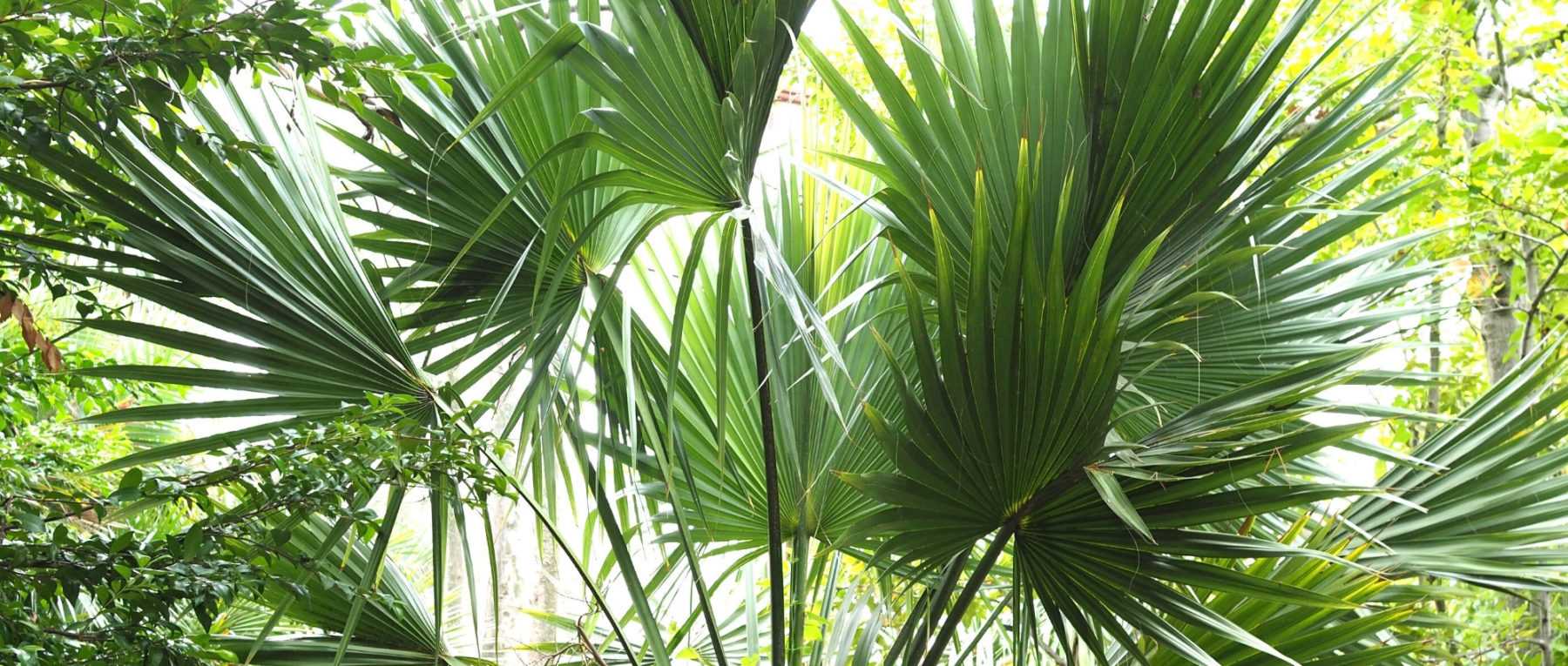
Sabal: Planting, Growing and Caring for Your Young Plant
Contents
Sabals in a nutshell
- Sabals are beautiful palms with palmate, fan-shaped leaves
- Their height varies greatly: there are dwarf Sabals and giant ones that can reach up to 20m tall!
- The most well-known are Sabal minor, a dwarf species, almost without a trunk, and Sabal palmetto
- Some species are very hardy, tolerating temperatures as low as -15°C
- They thrive in warm locations and fertile soil, preferably moist but well-draining
Our expert's word
Sabals comprise around fifteen species of magnificent fan-leaved palms, native to Central America and the southern United States. The most well-known and cultivated are the Sabal minor, a species that does not exceed 2 m in height, and the Sabal palmetto, which is much taller (up to 10 m). The height of these palms indeed varies greatly depending on the species: you’ll find giant Sabals, which will easily stand out as specimen plants or in rows in an exotic garden, as well as dwarf Sabals, perfect for container growing or planting in small urban gardens!
Sabals are prized in gardens for the excellent hardiness displayed by certain species! The Sabal minor, for example, can withstand temperatures of around -15°C, and many species are hardy down to -10°C. Some, however, like the Sabal mauritiiformis, cannot tolerate frost and should be reserved for southern gardens or grown in large containers under shelter.
Sabals thrive in warm, sunny locations (or partial shade for the Sabal minor and Sabal mauritiiformis), in fertile, loose and moist but perfectly drained soil. They need warmth and humidity for optimal growth. The smaller species adapt well to container growing, making it easy to bring them under shelter to protect them from winter cold. Sabals are perfect for enhancing a dry exotic garden, a large rockery, or a sunny terrace. Discover in this guide all our tips for successful cultivation, planting, care and pairing with other plants to create a stunning exotic display!
Botany
Botanical data
- Latin name Sabal sp.
- Family Arecaceae
- Common name Sabal, cabbage palm
- Flowering summer, in July-August, on mature specimens
- Height highly variable, up to 20 m
- Exposure full sun or partial shade depending on variety
- Soil type preferably fertile and moist
- Hardiness highly variable, between -3 and -20 °C
Sabal palms comprise 16 species of magnificent fan-leaved palms, still too rarely cultivated in gardens. They are naturally found in Mexico, the southern United States, the Caribbean, Central America, and as far as northern South America. Depending on the species, Sabals thrive in varied environments: some grow in humid zones, while others prefer drier terrain, sometimes even on dunes. Similarly, some Sabals grow in woodland understorey, while others are found in open areas, in full sun. This is a highly diverse group of palms, whether in terms of habitat, hardiness or their habit and height.
Sabals are valued in gardens because some exhibit excellent hardiness (like the Sabal minor, which tolerates temperatures down to -15°C, even -20°C), allowing them to be grown in the northern half of the country, under relatively cool climates. Others, however, are far more tender: like Sabal mauritiiformis, which cannot withstand temperatures below -3°C.
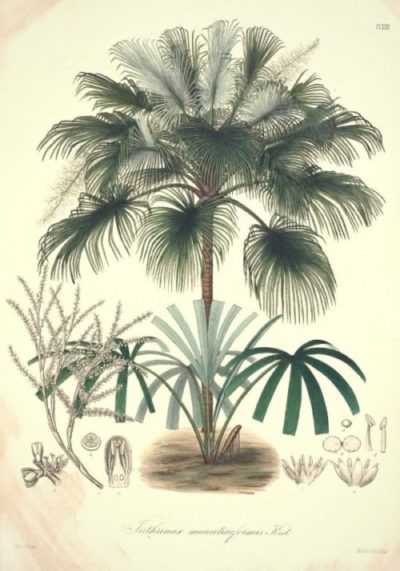
Sabal mauritiiformis: Botanical plate
Like other palms, Sabal belongs to the large botanical family Arecaceae. Palms are characterised by their solitary, usually erect stipe, topped with a crown of palmate (fan-shaped) or pinnate (feather-shaped) leaves.
The Sabal was named by botanist Michel Adanson. Its name appears to originate from a local Indian term.
The height of Sabals varies greatly: some grow very tall, up to 20 m for the Sabal mauritiiformis, while others are dwarf: the Sabal minor, for example, rarely exceeds 2 m in height. Sabals grow slowly, especially during their first years of cultivation, but they are exceptionally long-lived.
Sabals typically form an erect stipe, with a crown of leaves at the summit. However, Sabal etonia and Sabal minor develop an underground stipe, which may emerge from the soil but will never grow very tall. Most often, these palms appear almost stemless, without a visible stipe.
At the top of the stipe, the Sabal’s crown typically comprises 15 to 20 leaves, sometimes up to 30. The leaves are costapalmate: they are palmate, fan-shaped, but the petiole extends into a central axis. Depending on the species, this central axis is more or less visible. The fronds are thick, leathery, and usually measure between 1 and 2 m in diameter. They are deeply incised, divided into numerous slender segments. The leaves are often green, sometimes bluish, even grey (Sabal uresana). They are attached to the stipe by a long, smooth, thornless petiole, unlike other palms such as Brahea armata.
Generally, dead leaves persist on the stipe, below the crown of still-living green fronds. Over time, they eventually fall, but the base of the old leaf petioles remains attached to the stipe, typically forming very characteristic crosshatch patterns, as seen in Sabal palmetto and Sabal mexicana.
Sabals are capable of flowering quite early, while still young, unlike other palms like Brahea, which must wait at least 30 years before beginning to flower. Sabal palmetto, for example, can flower after just 10 years. Sabal flowering then occurs annually in summer, usually in July-August. The palm produces large branched paniculate inflorescences that emerge between the leaves. They consist of small three-petalled flowers, cream-white in colour.

A young frond of Sabal minor, and a leaf of Sabal palmetto, clearly showing the central axis extending from the petiole, giving the leaf a particular three-dimensional inclination (photo Katja Schulz) / the stipe of a Sabal etonia, with the persistent bases of petioles forming a characteristic crosshatch pattern typical of Sabals (photo Ryan Somma)
Sabals are monoecious (each specimen is simultaneously male and female). Their flowers are bisexual, bearing both stamens and pistils. A single specimen is therefore sufficient to produce viable seeds.
Sabal produces globose fruits (drupes), about 1 cm in diameter, initially green, then turning black at ripeness. Each fruit contains 1 to 3 seeds. They can be harvested for sowing.
Sabal fronds have traditionally been used in America to make thatched roofs, hats, baskets and ropes. The stipes, relatively resistant to decay and insects, are sometimes used as posts or pilings for construction. As for the berries, they have medicinal properties.

The flowering of Sabal bermudana, a close-up of Sabal minor flowers, and the fruits of Sabal bermudana (photos: Malcolm Manners / ikenaikoto / Emőke Dénes)
Read also
Palms: Planting, Growing and CaringThe main varieties of Sabal

Sabal palmetto - Cabbage Palm
- Flowering time August, September
- Height at maturity 8 m
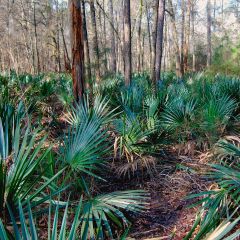
Sabal minor - Dwarf Sabal
- Flowering time August, September
- Height at maturity 2 m
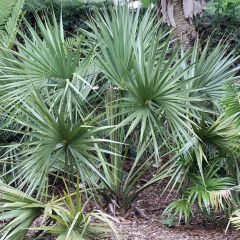
Sabal etonia - Scrub Palmetto
- Flowering time August, September
- Height at maturity 2,50 m
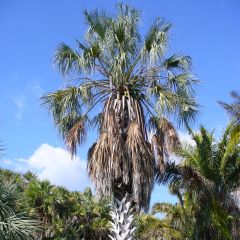
Sabal uresana - Sonoran Palmetto
- Flowering time August, September
- Height at maturity 15 m
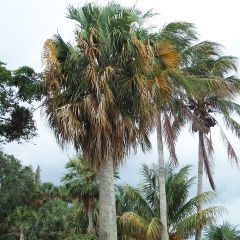
Sabal causarium - Puerto Rican hat palm
- Flowering time August, September
- Height at maturity 10 m
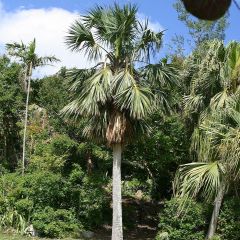
Sabal bermudana - Bermuda Palm
- Flowering time August, September
- Height at maturity 8 m
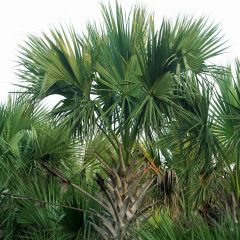
Sabal mexicana
- Flowering time August, September
- Height at maturity 10 m
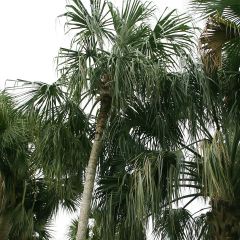
Sabal mauritiiformis - Trinidad Palm
- Flowering time August, September
- Height at maturity 18 m
When choosing your Sabal, consider hardiness! Sabal minor is the most resilient, tolerating temperatures down to -15°C. Sabal etonia, Sabal mexicana, Sabal palmetto, Sabal uresana, Sabal bermudana… can withstand -10°C.
Discover other Sabal
View all →Available in 1 sizes

Available in 5 sizes
Available in 1 sizes
Available in 3 sizes
Available in 1 sizes
Available in 1 sizes
Available in 1 sizes
Available in 1 sizes
Available in 2 sizes
Planting
Where to plant?
If you’re growing it in the ground, choose a Sabal suited to your climate. The Sabal mauritiiformis, for example, should be reserved for the mildest climates, such as the Mediterranean coast, where the risk of frost is very low. In northern France, you’d be better off choosing Sabal minor, which is much more cold-resistant.
We recommend planting Sabal in full sun, in a spot sheltered from cold winds. It grows better and faster when it benefits from significant warmth. Sabal minor and Sabal mauritiiformis also tolerate partially shaded positions. Sabals appreciate fertile, loose, humus-bearing soils that remain relatively cool, ensuring optimal growth. They can also tolerate dry soils, though they’ll grow more slowly.
You can also grow Sabal in a large pot. In this case, we recommend choosing the smallest species, such as Sabal minor or Sabal etonia, which don’t exceed 2 m in height.
When to plant?
Plant Sabal in spring, once the risk of frost has passed.
How to plant?
In the ground:
- Dig a large planting hole, two to three times the size of the root ball.
- Add well-rotted compost and some coarse sand, mixing them into the soil.
- Plant the Sabal in the centre, ensuring its trunk is straight and not burying the collar (the base of the trunk should be just at soil level or slightly above).
- Fill in with substrate.
- Water generously.
- You can create a watering basin around the trunk to make future watering easier.
Continue to water regularly during the summer following planting.
In a pot:
- Choose a large pot. It should have drainage holes to allow excess water to escape.
- Place a drainage layer at the bottom, such as gravel or clay pebbles.
- Then add a well-draining substrate, for example made of compost and coarse sand.
- Plant the Sabal in the centre of the pot.
- Fill in with substrate around the sides.
- Gently firm down.
- Water.
- Place the palm in a bright spot under cover if there’s a risk of frost, or outdoors in the sun (e.g., on your terrace) if temperatures allow.
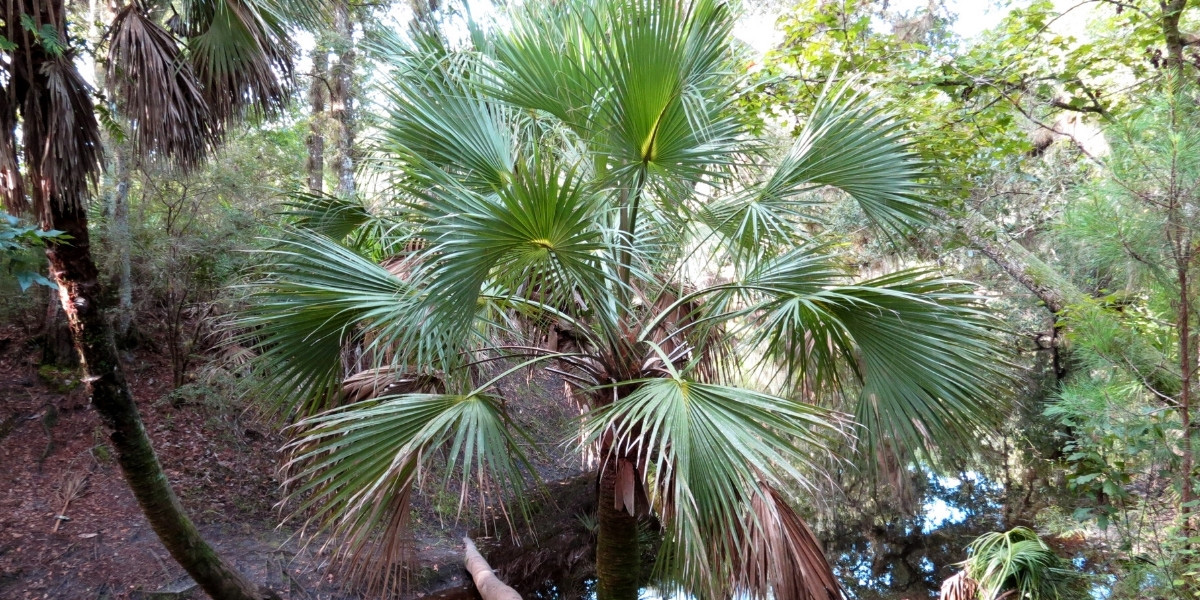
Sabal palmetto (photo Katja Schulz)
Maintenance
In the ground
Don’t hesitate to water the Sabal regularly in summer (especially during the first three years), as this is a palm that needs warmth and water to grow well. Its growth becomes much slower in case of drought. It takes several years to become well established and requires more regular care and watering during this period; afterwards, the Sabal will need very little attention.
You can add a little well-decomposed compost each year at the base of the Sabal, and lightly work it into the soil with a rake. Also consider applying an organic mulch around the base of the Sabal to help the soil retain moisture for longer.
When you see the older fronds (the lowest ones) drying out, you can prune them by cutting the petiole a few centimetres from the trunk.
If you’re growing a Sabal in the ground, even if it’s hardy (like the Sabal minor), we still recommend protecting it during the first few winters. Once mature, it will become more resistant to cold.
Discover all our advice on protecting palm trees in winter.
In pots
If growing in a pot, we recommend watering the palm at least once a week in spring and summer, or more if you notice the soil is dry. However, be careful not to let water stagnate in the saucer. It will also appreciate a liquid fertiliser once or twice a month during the growth period (remember to dilute it sufficiently, as a too-concentrated solution could burn its roots). In winter, reduce watering and stop fertilising.
Remember to repot it occasionally, at least once every three years. In years when you don’t repot, we recommend top-dressing by removing the top few centimetres of compost and replacing it with fresh potting mix.
If the Sabal you’re growing is not very hardy, or if you live in a rather cool climate, remember to bring it indoors in autumn, before the first frosts. Place it in a bright conservatory or greenhouse, frost-free but rather cool. Avoid placing it inside your house or flat, as temperatures might be too high for it. Even though it needs protection from frost, it requires a period of rest with slightly cooler temperatures in winter.
When bringing it indoors in autumn and moving it back to your terrace in spring, avoid sudden changes in temperature and light levels! We recommend acclimatising it gradually, for example in spring by initially placing it outside in partial shade until it adjusts, before leaving it outdoors in full sun.
Diseases and parasitic pests
Indoors, the Sabal can sometimes be attacked by red spider mites. These are tiny insects, barely visible to the naked eye, which pierce the leaves or petioles and feed on the sap. In case of infestation, small webs may be seen on the palm. To eliminate them, misting the foliage is best, as they dislike humidity and proliferate in dry conditions.
Also watch out for scale insects (mealybugs or hard-shelled). Like red spider mites, these insects settle on the palm, pierce the tissues and consume the sap, weakening the plant. Initially, you can remove them manually when spotted, but if the infestation worsens, we recommend treating with an anti-scale solution. For example, mix one teaspoon of black soap, one teaspoon of methylated spirits, and one teaspoon of rapeseed oil diluted in one litre of water. Simply spray this solution onto the infested Sabal’s foliage.
Outdoors, the Sabal may be targeted by the Paysandisia archon moth or the red palm weevil, two insects particularly active in southern France that cause significant damage to palms. Symptoms include perforated fronds (holes aligned horizontally), a drooping crown, or premature frond drop. Feel free to check out our dedicated guides to learn more about these pests, identify them, and treat your palms:
Propagation
Sowing
It is possible to harvest the seeds of the Sabal and sow them. Remember to clean them thoroughly to remove the fruit pulp around the seed.
Sowing takes place in spring.
- Start by soaking the seeds in water for two to three days, changing the water twice a day.
- Next, prepare pots with a well-draining medium, such as a mix of compost and sand, or special sowing compost.
- Place the seeds on the medium.
- Cover them with compost, about 1 to 2 cm deep.
- Gently firm the soil.
- Water.
- Position the pots in a bright spot, out of direct sunlight, at a temperature between 20 and 30°C. Ideally, daytime temperatures should be higher (25-30°C) and cooler at night (20-25°C). You can also use a mini greenhouse to keep the pots in a warm, humid environment. In this case, remember to ventilate regularly.
Ensure the medium remains slightly moist until germination.
Sabals can take a very long time to germinate—you may see shoots develop after a few months, but they can also take up to a year before they start growing. Be patient! Similarly, these palms grow slowly, especially when young, during the first five to ten years.
Association
With its large, highly graphic palmate leaves, the Sabal will easily become the centrepiece of an exotic garden! Create a lush, luxuriant scene by pairing it with the generous foliage of Tetrapanax, Japanese Banana Trees (Musa basjoo), Fatsia japonica, Datisca cannabina, Gunnera manicata, Cycas… To enhance the “jungle” effect, incorporate some climbing plants, which will play the role of lianas and can climb up the trunks of palm trees or the foliage of bushes. Consider, for example, Akebia quinata, trumpet vine, or passionflower. You can also include ferns, such as the splendid Blechnum novae-zelandiae, and arborescent ferns (for example, the Dicksonia antarctica). Don’t forget about bamboos, which will provide a beautiful backdrop for this exotic scene. Also consider the striking Yuccas, Cordylines, and Phormiums, as well as ornamental grasses like Hakonechloa macra.
All these plants will create a magnificent green setting, overflowing with foliage. Add small splashes of colour with the flowering of crocosmias, kniphofias, agapanthus, hedychiums, or lantanas. Opt for warm, vibrant hues (red, orange, yellow…), which give a very exotic effect. Also discover the splendid Strelitzia reginae, aptly nicknamed the Bird of Paradise. This style of ambience is perfect, for example, around a swimming pool, giving your garden a true holiday and exotic vibe!
Since the Sabal prefers fertile, moist soil, avoid planting it in a rockery or arid, dry exotic garden (reserve this for other palms that thrive in dry, poor soil, such as the Brahea). It’s better suited to cooler, more luxuriant settings!
In partial shade, you can pair Sabal minor with the Rhapidophyllum hystrix palm or the Trachycarpus fortunei. Like the Sabal, they adapt very well to shaded conditions.
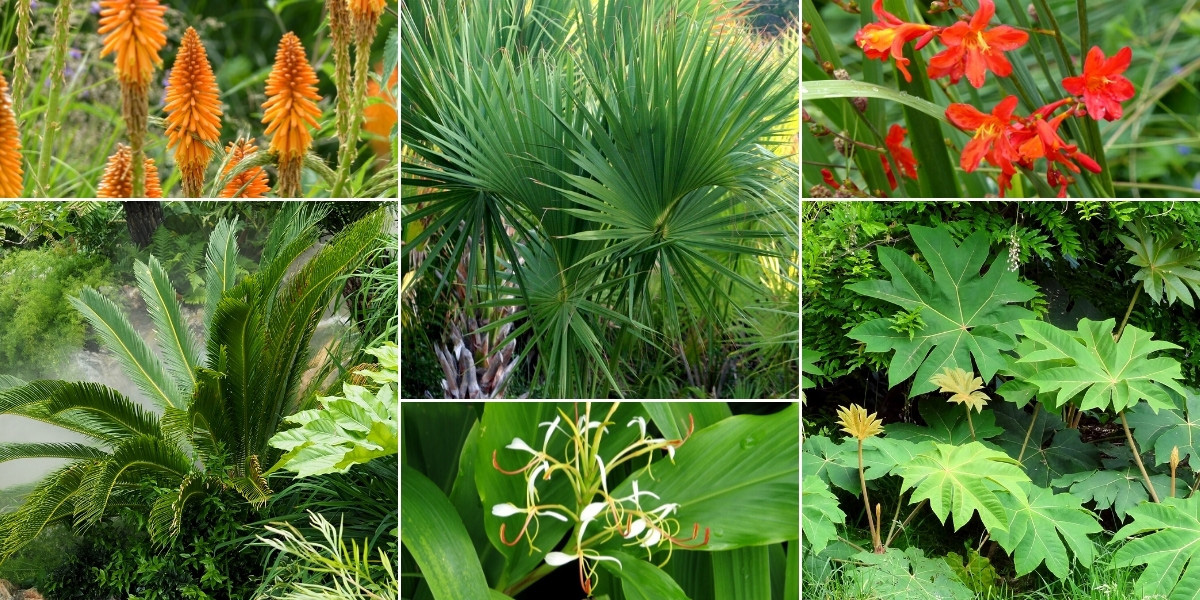
Create a jungle garden with Kniphofia ‘Fiery Fred’, Sabal mexicana (photo Whitney Cranshaw), Crocosmia ‘Carmin Brilliant’, Cycas revoluta, Hedychium spicatum (photo peganum), and Tetrapanax papyrifera ‘Rex’
Useful resources
- Discover our full range of Sabal palms!
- “Palm Trees: Planting, Growing and Care”
- For more ideas on cold-hardy palm trees, check out our guide “7 Hardy Palm Trees to Plant Almost Anywhere in France”
- The website of Les Fous de Palmiers association, featuring a forum
- Book Understanding Palm Trees by Pierre-Olivier Albano, published in 2002 by Edisud
- Another website with extensive information on palm tree cultivation
- Our advice sheet: Palm Trees by Climate
- Subscribe!
- Contents






































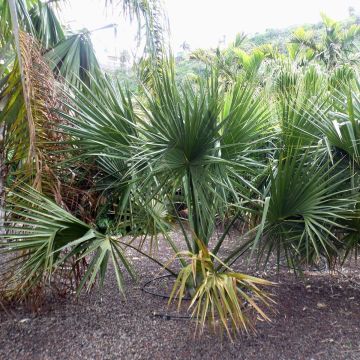

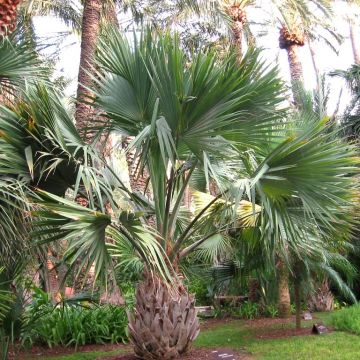
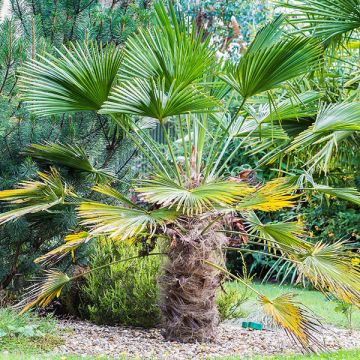

Comments